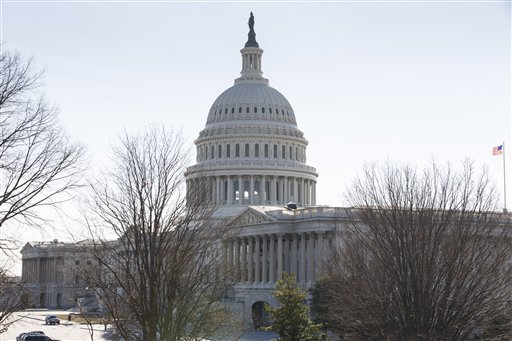Ap Us Government Chapter 3 Reading Guide
The System of Checks and Balances
In 1787 leaders of the states gathered to write the Constitution-a set up of principles that told how the new nation would be governed.
The leaders of the states wanted a strong and fair federalgovernment. But they as well wanted to protect private freedoms and preclude the U.S. regime from abusing its power. They believed they could exercise this by having three branches of authorities: the executive, the legislative and the judicial. This separation of powers is described in the first iii manufactures, or sections, of the U.Southward.Constitution.
Legislative Branch

The Capitol Building in Washington D.C. is where the legislative branch works.
Source: AP Photo/J. Scott Applewhite
The legislative branch is fabricated up of the ii houses of Congress?the Senate and the House of Representatives. The nearly important duty of the legislative branch is to make laws. Laws are written, discussed and voted on in Congress.
There are 100 senators in the Senate, 2 from each state. Senators are elected past their states and serve 6-year terms. The Vice President of the U.S. is considered the head of the Senate, only does not vote in the Senate unless in that location is a tie. The Senate approves nominations fabricated by the President to the Cabinet, the Supreme Court, federal courts and other posts. The Senate must ratify all treaties by a two-thirds vote, and the tin also vote to impeach the president if they are accused of a crime.
In that location are 435 representatives in the House of Representatives. The number of representatives each state gets is based on its population. For example, California has many more representatives than Rhode Island. When Census figures determine that the population of a country has changed significantly, the number of representatives in that land may shift proportionately. Representatives are elected by their states and serve ii-yr terms. The Speaker of the House, elected past the representatives, is considered the head of the Business firm.
Both parties in the Senate and the House of Representatives elect leaders. The leader of the party that controls the business firm is chosen the majority leader. The other party leader is called the minority leader.
Come across also:Congress
Executive Branch

The White House is where the President works.
Source: AP Photo/Susan Walsh
The President of the United States is the head of the executive branch, which makes laws official. The President is elected by the entire country and serves a four-yr term. The President approves and carries out laws passed by the legislative branch (or he can veto them). He appoints or removes cabinet members and officials. He negotiates treaties, and acts as caput of country and commander in chief of the war machine.
The executive co-operative also includes the Vice President and other officials, such as members of the cabinet. The cabinet is made up of the heads of the 15 major departments of the government. The chiffonier gives communication to the President about important matters.
The Cabinet
- The Secretary of State
- The Secretary of the Treasury
- The Secretary of Defense
- The Attorney General (Justice Department)
- The Secretary of the Interior
- The Secretary of Agriculture
- The Secretary of Commerce
- The Secretary of Labor
- The Secretary of Wellness and Man Services
- The Secretary of Homeland Security
- The Secretarial assistant of Housing and Urban Development
- The Secretary of Transportation
- The Secretary of Teaching
- The Secretarial assistant of Energy
- The Secretary of Veterans' Affairs
The Executive Co-operative as well includes federal agencieslike the EPA.
Run into also:Presidents.
Judicial Branch

The Supreme Courtroom building is where the 9 justices meet.
Source: AP Photograph/Carolyn Kaster
The judicial branch oversees the court arrangement of the U.South. Through courtroom cases, the judicial branch explains the meaning of the Constitution and laws passed by Congress. The Supreme Court is the caput of the judicial branch. Different a criminal court, the Supreme Court rules whether something is ramble or unconstitutional?whether or not information technology is permitted under the Constitution.
On the Supreme Court in that location are nine justices, or judges: eight associate justices and one primary justice. The judges are nominated by the President and approved by the Senate. They have no term limits. The Supreme Court is the highest court in the land. Its decisions are final, and no other courtroom can overrule those decisions. Decisions of the Supreme Court set precedents?new ways of interpreting the police.
Meaning Supreme Court Cases
- 1803 Marbury 5. Madison? was the first time a law passed past Congress was declared unconstitutional
- 1857 Dred Scott v. Sanford?Declared that a slave was not a citizen, and that Congress could not outlaw slavery in U.S. territories
- 1896 Plessy five. Ferguson?Said that racial segregation was legal
- 1954 Brown 5. Board of Education?Fabricated racial segregation in schools illegal
- 1966 Miranda v. Arizona?stated that criminal suspects must be informed of their rights before being questioned by the police force.
- 1973 Roe v. Wade?Made ballgame legal
- 2003 Grutter v. BollingerandGratz 5. Bollinger?Ruled that colleges tin, under certain conditions, consider race and ethnicity in admissions.
- 2010 Citizens United 5. Federal Ballot CommissionThe Supreme Court ruled, 5–4, that the government cannot restrict the spending of corporations on political campaigns, maintaining that it's their Offset Amendment right to back up candidates as they choose.
- 2013 Shelby Canton v. HolderThe Supreme Courtroom struck down Section four of the Voting Rights Act, which established a formula for Congress to use when determining if a state or voting jurisdiction requires prior approval before changing its voting laws.
Run into also:Supreme Courtroom.
Source: https://www.factmonster.com/us/government/three-branches-of-government
Post a Comment for "Ap Us Government Chapter 3 Reading Guide"